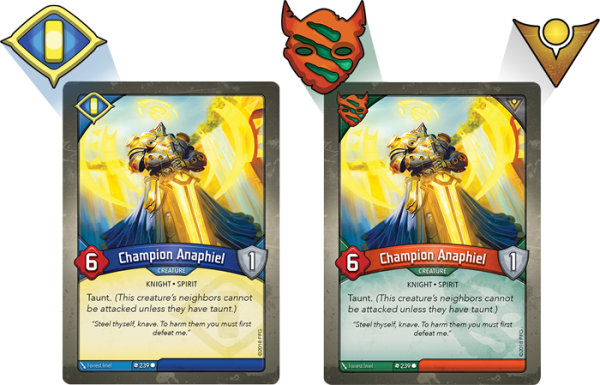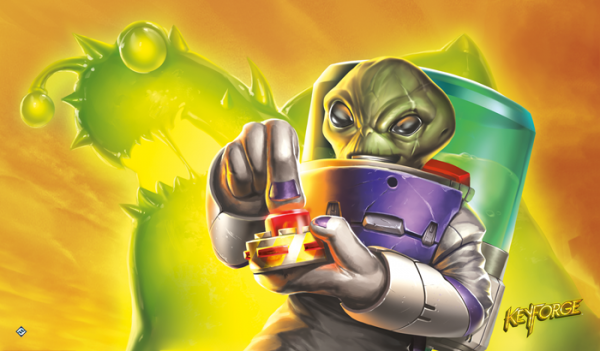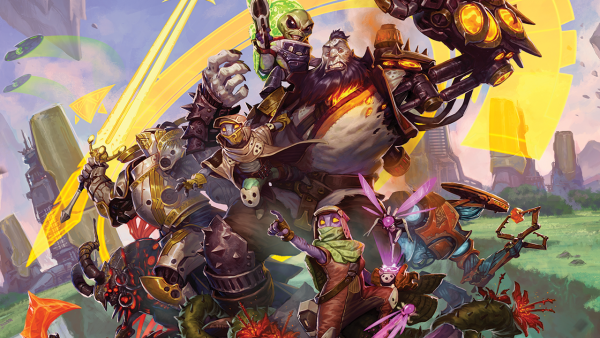So, Fantasy Flight Games worked with Richard Garfield and come up with an entire new class of card games. To be honest, I haven’t touched it yet, but the idea is intriguing. I don’t know if it’s my bubble, or if it really is making waves, but hey, it’s an entire new concept from the man who pretty much revolutionized card games.
The name of the game is KeyForge, and it’s an Unique Deck Game. What does that mean? It means that every deck you buy is a procedurally generated, unique deck. It also means that you’ll play the deck as it comes out of the box, without ever making changes to it. There is no deckbuilding.
This part I definately needed to warm up on. Part of why I like Magic: The Gathering is that it is a form of expression. I play the game the way I like to play it, with cards of my own choosing. But, reading the justifications Richard Gardfield made on the Unique Deck System it does make sense. Am I really free to play any deck in Magic? The truth is, there are so many cards that most cards just don’t ever make the cut in my decks, and the metagame forces my hand if I want to play something competative.
Sure, I play Commander a lot, which does allow me to include some pet cards, and Draft, which restricts my card pool, but in a Unique Deck Game all my cards are relevant. At least that’s efficient.
I will miss both customisation and “leveling up” my decks. The only way to improve a KeyForge deck is playing it and learning all the lines of play, and discover it’s potential. The only way to really “deckbuild” is to think of a hypothetical deck I want and buy the closest thing I can find on the secundairy market. – But that’s more of a hack than the intended way to play. And even then, the deck will never upgrade, only downgrade due to the chain system.
Yes, there are billions of possible decks, but there are around 50 different cards per House, and you get 12 of them in any deck. Since the Houses should at least have some self-synergy, the archetypes become at least a little bit limited, so some decks should at least share archetypes. Still, each deck has 3 houses, so there are still a lot of combinations. I also heard there is a chance a “Maverick” card shows up, where a card from a House is printed in a different House, which is exciting and throws the system a curveball. I don’t know how often that happens though.
Normally, Anaphiel is house Sanctum, but he can show up as a Maveric Untamed card.
Missing out on leveling up your deck and customising it does impact the balance though. And that is seen in the gameplay itself. Since you can’t throw in all the best cards you have and call it a deck, the game can offer some freedom, like the the complete abscence of a mana-system. In Magic, the factor limiting the amount of big, swingy cards is the mana system involved. You could put in 40 7-mana creatures, and all of them would be very powerful, but you’re likely to be overrun before you get started.
Since you dont make a KeyForge deck, the balance of the cards kinda has been dealt with already. Sure, it’s possible to play a couple ginormous monsters on your first turn, but the game has you covered.

Tabris is an example of a creature that can be considered “big.”
First, there is the house system. On each turn you can play and use and do other things with cards from one of your houses only. This often means that at one point you’ll have to choose between using cards on the table, or playing new ones.
The second is that this game is not about attacking opponents, but about forging keys. So, a big creature like Champion Tabris does have a good time fighting other creatures, but doesn’t help fighting opponents directly, since that option isn’t really there. So, while she is trouble, she doesn’t end the game much quicker than a small creature. The dynamic here is that you’ll have to forge 3 keys, and that can require Ember. Creatures are a way of generating Ember, but most of them ‘reap’ Ember one at a time. Combat is more about controlling how many creatures each player has, and how quickly they can generate Ember.
Another big difference with Magic is that in KeyForge, turns are isolated. This means that you can’t do anything on your opponents’ turn. So, no sudden counters or combat tricks. This does make the game a bit more accesable for some players. There is no frustration of having your spell countered, for example. While some players will miss this kind of interaction, it also forces you to play ahead a little more. However, it can create situations where things happen, and you don’t have an option to do anything about it. Then again, how often are such things relevant in a game of Magic?
So far, it seems like there where choices made that are defendible and make sense in context of this game. Also the cost of entry seems low; For just 10 euro you’ll have a deck. Sadly, that means missing out on some components, like Ember tokens, damage tokens and stun tokens, as well as the Chain tracker. These are included in the big, 40 euro box, which also has 2 random decks and 2 fixed decks. That’s a more expensive point of entry, but to be fair, still cheap compared to CCG’s in the long run.
The UDG (Unique Deck Game) system is pretty clever. The card game market is pretty saturated, and just a few CCG’s are doing fine. Magic has a solid fanbase, Pokémon and Yu-Gi-Oh are doing fine internationally, but after that the player base drops off significantly. Fantasy Flight Games did move to the Living Card Game years ago, with fixed, you-know-what-is-in-the-pack expansions. Some of these games ended as well, because even coming up with 20 new cards monthly or so still is a lot of work.
The UDG Model means coming up with a significant card pool once, but since the decks are semi-random/procedurally generated, and you don’t upgrade your decks, the card pool can be sustained for quite a while. I do wonder about the future plans for this games, and changes to the card pool and other updates. The only expensive part about the game is that it requires special printing technologies to make every deck unique, not only in card contents, but in the procedurally generated card back and deck names. Also fun is that, at least with the print run, you can end up with some, let us say, unique decknames, as the algorith for generating decknames sometimes came up with some unfortunate combinations of words.
I don’t think that’s a bug, but a feature, however FFG ofcourse thinks differently. I can understand how they wanted to avoid printing a deck that’s called The Emperor Who Pays For Boys, for example. They fixed that problem in subsequent print runs, which means missing out on some collectors items.
Anyways, the procedural stuff makes creating new content quite sustainable, and this could be a game that’s around for years, even decades, maybe.
I did watch somes games on Youtube and the game looked like fun. I wonder how long you can milk a deck before getting bored with it, but getting a new one isn’t that expensive.
There are a few gripes I have, though. Granted, most of them apply to playing tournaments, and shouldn’t pose a problem in kitchen table games.
Once a card goes missing from your deck, it makes the entire deck useless. This means paying close attention in public places. I don’t know if someone will misplace a card on purpose to sabotage my deck – I doubt it – but if that happens, there is no replacing the missing card.
Then there is the “Check!” rule. If you have enough Ember to forge a key at your next turn, you’re supposed to warn the opponent and say “Check!” – I don’t know how enforcable this is in a tourney setting; You might say it, but your opponent isn’t paying attention somehow, then blames you for not saying it. It’s not one of the best rules. Everyone should pay attention to the gamestate by themselves, right? Also, the fact that you are forced to forge a key at the beginning of your turn if able seems like a weak rule. Now I have to remind you that you must take an action to win the game? I hope these weak rules go the way of manaburn. Pay attention to your own game!
As for tournament rules; FFG stated that if you want to sleeve a deck, use opague sleeves. This seems like a bit of a design flaw. Sure, it helps a bit against cheating, since every deck has a unique card back, and it helps avoiding sneaking in some good cards from other decks. But if the card front was better designed so such tricks are more obvious at a glance than they are now, this could have been avoided. What can I say, I like using sleeves to add a bit of personality to my decks. And transparent penny sleeves generally are flimsy and don’t shuffle well.
Then there was something said about using dice to keep track of stuff. I know, dice can roll over, but that’s a matter of responsibility. You can’t use dice though, according to the rules. Meh. It doesn’t help that the only reason to buy the 40 euro box are the cardboard components. Well, dice are perfect components. And since chains work with increments of 6, D6’s are good components to keep track of that too. And they’re good for helping keep track of damage on creatures, and work well as a stun counter.
These are minor, but somewhat aggrevating cases of meddling though.
What you get is a game where every opponent is (at least somewhat) different and you won’t face the same metagame deck one after the other. Entry is cheap, and for some people, building a deck is a huge hurdle. KeyForge is pickup and go. You’ll own a one-of-a-kind thing, with it’s unique name and card back. Reception has been good, so it shouldn’t be that hard to find other players, eventually. Pick it up quickly enough and you have a chance of getting a really problematic deckname, which are banned in tournaments, but at the very least make a good, unique collectors item.







